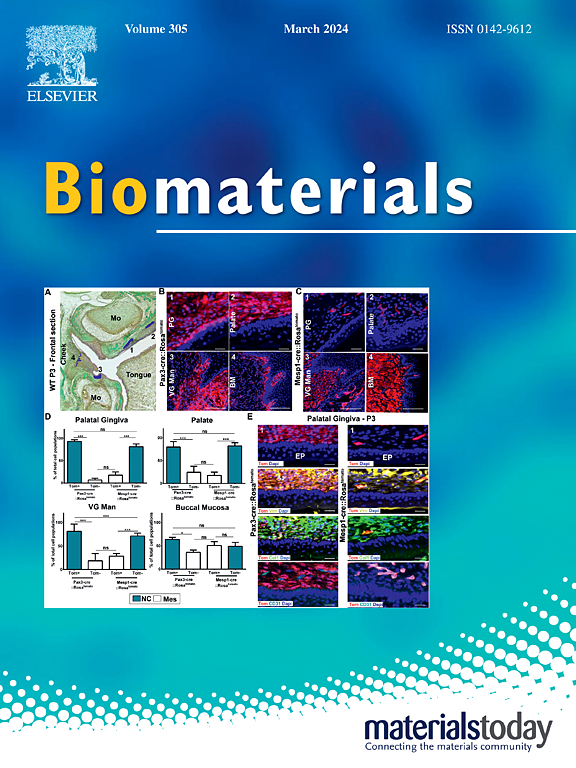Transduction enhancing EF-C peptide nanofibrils are endocytosed by macropinocytosis and subsequently degraded
IF 12.9
1区 医学
Q1 ENGINEERING, BIOMEDICAL
引用次数: 0
Abstract
Retroviral gene transfer is the preferred method for stable, long-term integration of genetic material into cellular genomes, commonly used to generate chimeric antigen receptor (CAR)-T cells designed to target tumor antigens. However, the efficiency of retroviral gene transfer is often limited by low transduction rates due to low vector titers and electrostatic repulsion between viral particles and cellular membranes. To overcome these limitations, peptide nanofibrils (PNFs) can be applied as transduction enhancers. Among these, PNFs derived from the 12-mer peptide EF-C are well-investigated and commercially available. EF-C PNFs enhance transduction by forming EF-C PNFs/virus complexes that overcome electrostatic repulsion through their polycationic surface and interaction with cellular protrusions. However, the safe application of PNFs as transduction enhancers in gene therapeutic applications requires a fundamental understanding of their transduction-enhancing mechanisms, uptake, and degradation. In this study, we demonstrate that EF-C PNFs induce plasma membrane invaginations, increasing the membrane surface for viral attachment and reducing the distance to the nuclear membrane, thereby facilitating viral entry and transport to the nucleus. Furthermore, we identified macropinocytosis as the main entry pathway for EF-C PNFs and their subsequent degradation by lysosomal peptidases. The lysosomal degradation of EF-C PNFs prevents their accumulation as amyloid deposits, mitigating potential side effects and supporting their safe use in clinical applications.

增强转导的EF-C肽纳米原纤维被巨噬细胞吞噬并随后降解。
逆转录病毒基因转移是将遗传物质稳定、长期整合到细胞基因组中的首选方法,通常用于生成靶向肿瘤抗原的嵌合抗原受体(CAR)-T细胞。然而,由于低载体滴度和病毒颗粒与细胞膜之间的静电排斥,逆转录病毒基因转移的效率往往受到低转导率的限制。为了克服这些限制,肽纳米原纤维(PNFs)可以用作转导增强剂。其中,从12聚肽EF-C衍生的pnf得到了很好的研究,并且可以在商业上获得。EF-C PNFs通过形成EF-C PNFs/病毒复合物,通过其多阳离子表面和与细胞突起的相互作用克服静电排斥,从而增强转导。然而,PNFs作为转导增强剂在基因治疗中的安全应用需要对其转导增强机制、摄取和降解有基本的了解。在这项研究中,我们证明了EF-C PNFs诱导质膜内陷,增加了病毒附着的膜表面,减少了到核膜的距离,从而促进了病毒进入和运输到细胞核。此外,我们发现巨噬细胞作用是EF-C PNFs的主要进入途径,并随后被溶酶体肽酶降解。EF-C PNFs的溶酶体降解阻止了它们作为淀粉样蛋白沉积的积累,减轻了潜在的副作用,并支持其在临床应用中的安全使用。
本文章由计算机程序翻译,如有差异,请以英文原文为准。
求助全文
约1分钟内获得全文
求助全文
来源期刊

Biomaterials
工程技术-材料科学:生物材料
CiteScore
26.00
自引率
2.90%
发文量
565
审稿时长
46 days
期刊介绍:
Biomaterials is an international journal covering the science and clinical application of biomaterials. A biomaterial is now defined as a substance that has been engineered to take a form which, alone or as part of a complex system, is used to direct, by control of interactions with components of living systems, the course of any therapeutic or diagnostic procedure. It is the aim of the journal to provide a peer-reviewed forum for the publication of original papers and authoritative review and opinion papers dealing with the most important issues facing the use of biomaterials in clinical practice. The scope of the journal covers the wide range of physical, biological and chemical sciences that underpin the design of biomaterials and the clinical disciplines in which they are used. These sciences include polymer synthesis and characterization, drug and gene vector design, the biology of the host response, immunology and toxicology and self assembly at the nanoscale. Clinical applications include the therapies of medical technology and regenerative medicine in all clinical disciplines, and diagnostic systems that reply on innovative contrast and sensing agents. The journal is relevant to areas such as cancer diagnosis and therapy, implantable devices, drug delivery systems, gene vectors, bionanotechnology and tissue engineering.
 求助内容:
求助内容: 应助结果提醒方式:
应助结果提醒方式:


